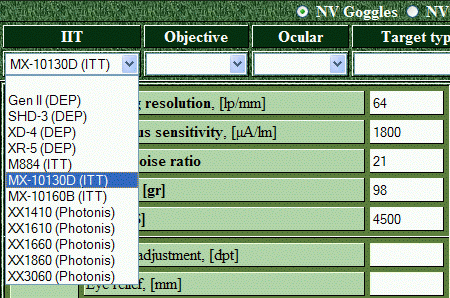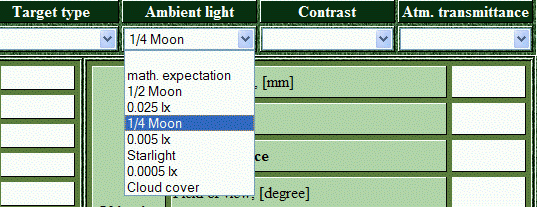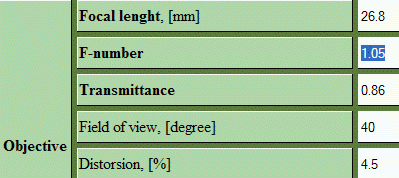



| Main menu | Help | About |


 |
 |
|
1. Introduction The system "NVDpro" is successor of the software system for night vision goggles design "NVGpro". It was extended as "NVDpro" to cover not only night vision goggles but also other types of night vision devices with magnification α>1, i.e. night vision binoculars and night vision sights. The "NVDpro" is designed as a "decision maker" tool for the choice of the NVD optoelectronic channel modules - objective, image intehsifier tube, ocular and for calculating of the preliminary theoretical estimation for basic NVD operational characteristics - detection, recognition and identification ranges, magnification, weight and price of the optoelectronic channel. These data are essential from practical point of view for the overall estimation of the designed device operational functionality. The system can be used to increase efficiency of the NVD design process by virtual simulating it in computer enviroment decreasing the need of multiple prototypes building and testing. It implements "reasonable combinatorial choice" method [1] for automatic choosing of the modules combination to satisfy the designer requirements and original formula for calculating of the NVD working range [2]. The system "NVDpro" is developed as a Web-based application [3] - stored, updated and maintained on the server-side and is accessible on the client-side through Internet by any JavaScript capable browser. The work sessions data and results are stored on the client-side and are not accessible to the other system users. 2. Functional description The NVD design starts with choosing of the NVD type by means of the "radio-buttons". All modules conbinations for night vision goggles give magnification α=1. Other NVD types - binoculars and weapon sights have magnification α>1 depending on the chosen objective and ocular combination. The main optoelectronics channel modules (IIT, objective, ocular) and the external surveillance conditions from the implemented databases are chosen by means of the "drop-down lists".  The external surveillance conditions - ambient light, contrast between background and target and atmospheric transmittance could have given deterministic values known for the expected geographic, climatic etc. conditions or the mathematical expectation values from their probabilities distributions.  As a result of the IIT, objective and ocular choice the modules parameters fields are loaded with their values. All parameters fields can be edited for cases when the real data differs from the loaded ones. That editing capabilities can be used also to define required parameters data for production of custom modules. (Note: The values entered for focal lengths of the objective and ocular should be equal for the case of night vision goggles design!}  The NVD operational characteristics (detection, recognition and identification ranges, magnification, weight and price) are calculated after pressing the button "calculation". The calculated results are shown in the relevant data fields.  All of these data fields are editable. The user can enter there a required value for one parameter at a time. The entered value for the working ranges and magnification is considered as a lower limit and for the weight and price is considered as an upper limit. After pressing of the button "calculation" the "reasonable choice" mechanism is activated and a modules combination satisfying the required value (for the chosen external surveillance conditions) is found and shown. When it is impossible to find a feasible modules combination to satisfy the requirement a message is shown and last results are kept intact. Note: If more then one results value is entered as required value the upper positioned one is considered only . Clearing of the all data fields is done by the button "reset". If some input data from the "drop-down lists" are empty a reminding message is shown and calculation is not possible. If the user makes a new choice by the "radio-buttons" or by the "drop-down lists" the results data fields are cleared. The button "main menu" activates the main menu of the system "NVDpro". The button "print" prints the main menu screen on the default printer. The button "help" shows the current help page. The button "about" shows the page with information about the developers and version of the system. 3. Copyright notice The current "NVDpro" version is a demo-version and is constantly changing and updated. All used modules and their parameters are illustrative examples with data close to the real ones but are not intended to be used for practical application. The system itself is not guaranteed to be free of errors and a friendly feadback from the users will be highly appriciated. The demo-version of the system "NVDpro" can be used without limitation for educational and research goals as far as references are mentioned as citations. 3.1. References:
3.2. Contact information
|
|||||||